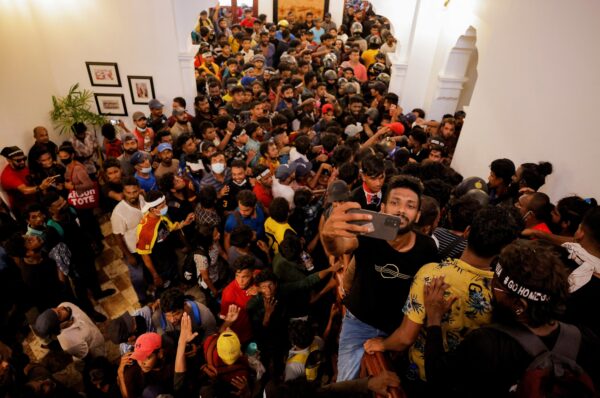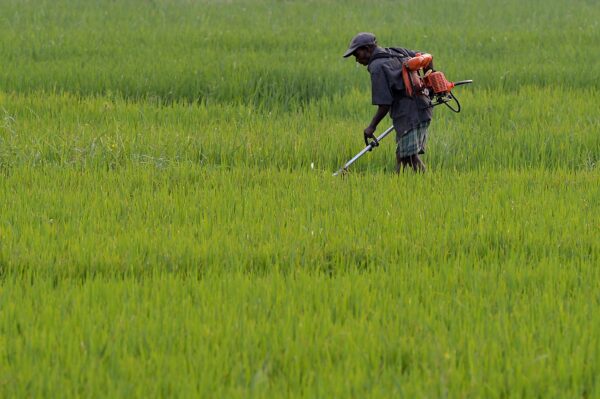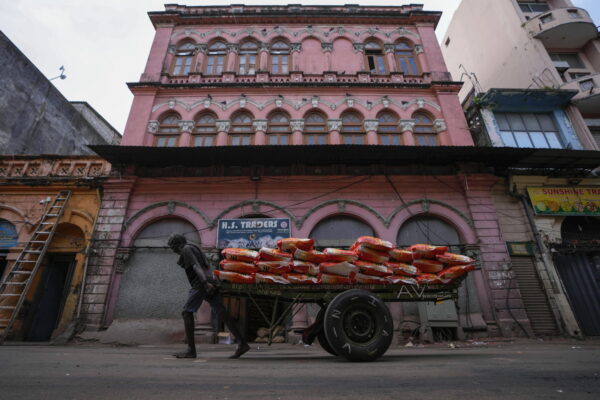Sri Lanka’s Agrochemical Ban Shows How Bad Ideas Can Have Big Consequences
CommentaryYou may remember the headlines: in 2021, Sri Lanka’s government imposed a total ban on agrochemicals. The restrictions affected both chemical fertilizers and pesticides. The government changed course in late 2021, but the damage had already been done. Yields fell dramatically, fueling anger in the streets. By mid-2022, the country was convulsed by explosive protests. In a matter of months, the prime minister and president both resigned. Protesters wait to enter into Sri Lankan Prime Minister Ranil Wickremesinghe’s office during a protest demanding for his resignation, after President Gotabaya Rajapaksa fled, amid the country’s economic crisis, in Colombo, Sri Lanka, on July 13, 2022. (Dinuka Liyanawatte/Reuters) A nation that once grew enough rice to feed itself was reduced to begging for handouts from India and China. That outcome is as devastating as it was predictable. What happened to my country—and what can its painful lesson teach the world? President Chooses Scarcity Over Food Security The people of Sri Lanka have been growing rice for thousands of years. The ancient Sinhalese built massive irrigation works to support large-scale rice cultivation. Thanks to the 20th century’s green revolution and the efforts of researchers in Sri Lanka’s agriculture department, the country significantly boosted its rice production, achieving larger yields than ever before. It also recently reached self-sufficiency in vegetable growing. Yet in early 2021, during a rice planting season known as “Maha,” things suddenly changed. Prominent Sri Lankans pressured then-President Gotabhaya Rajapakse to switch the country over completely to organic farming. The stated motivations included avoiding disease, including kidney disease, that have been linked to synthetic pesticides in Sri Lanka. In April 2021, over the objections of scientists, Rajapakse pulled the trigger on a sweeping agrochemical ban. The considerations guiding Rajapakse’s choice are still murky. In the months that followed, Sri Lankans discovered why no other country in the world only uses organic manure for its fertilizer–and why Bhutan abandoned a similar scheme a decade ago. The Fertilizer Crisis I am one of the scientists who objected to the president’s decision at the time. My fellow scientists and I argued that a rapid and complete shift to organic agriculture would cause widespread hunger. We were right. According to the United Nations’ World Food Program, some six million Sri Lankans–a third of the population–are now food insecure. That’s up significantly from 2014-2016, when the U.N.’s Food and Agriculture Organization reported that just 6 percent of the population faced moderate or severe food insecurity. The turn to organic farming was motivated by concerns with the natural environment and would supposedly make things better. Yet, organic farming is no panacea. Manure is a source of greenhouse gasses. It can also contribute to heavy metal pollution. Of course, concerns over chemical fertilizers are far from baseless. When used indiscriminately for long periods, those agrochemicals can denude the soil of symbiotic microorganisms. That, in turn, can increase farmers’ dependence on chemical fertilizers, creating a vicious cycle. The wisest course of action is to combine organic and chemical fertilizers, protecting the soil while maintaining crop productivity. Such a strategy also lets farmers tailor their approach to particular crops, which can have very specific nutrient demands. While adding compost can enhance soil texture and replenish vital micronutrients, it isn’t enough to meet the fertilizer requirements of high-yield rice varieties—the cornerstones of Sri Lanka’s agricultural sector. A Sri Lankan farmer works in a paddy field on the outskirts of Colombo on Jan. 9, 2016 (Lakruwan Wanniarachchi/AFP via Getty Images) It boils down to basic science. Compost is just 2 percent nitrogen, while a common, low-cost nitrogen fertilizer, urea, is about 46 percent nitrogen. Pesticides, another target of the ban, can also be environmentally harmful when overused or misapplied. Many Sri Lankan farmers do, in fact, use pesticides excessively; they’re an easy means of eliminating vermin and a path to greater profits. Yet, instead of promoting integrated pest management or other proven tactics to curb pesticide use, the state made things more baffling for farmers. The country’s Department of Agriculture was decentralized, and provincial governments came to exercise greater influence. (Many of my colleagues and I want these changes reversed.) Government agencies, private pesticide companies, leading farmers, and non-governmental organizations bombarded Sri Lankan farmers with conflicting messages. That made it hard for them to know what to do. Even today, after the lifting of the agrochemical ban, farmers cannot easily get their hands on pesticides. Bungled Execution by Government When the agrochemical ban came into effec

Commentary
You may remember the headlines: in 2021, Sri Lanka’s government imposed a total ban on agrochemicals. The restrictions affected both chemical fertilizers and pesticides.
The government changed course in late 2021, but the damage had already been done.
Yields fell dramatically, fueling anger in the streets. By mid-2022, the country was convulsed by explosive protests. In a matter of months, the prime minister and president both resigned.

A nation that once grew enough rice to feed itself was reduced to begging for handouts from India and China. That outcome is as devastating as it was predictable.
What happened to my country—and what can its painful lesson teach the world?
President Chooses Scarcity Over Food Security
The people of Sri Lanka have been growing rice for thousands of years. The ancient Sinhalese built massive irrigation works to support large-scale rice cultivation.
Thanks to the 20th century’s green revolution and the efforts of researchers in Sri Lanka’s agriculture department, the country significantly boosted its rice production, achieving larger yields than ever before. It also recently reached self-sufficiency in vegetable growing.
Yet in early 2021, during a rice planting season known as “Maha,” things suddenly changed.
Prominent Sri Lankans pressured then-President Gotabhaya Rajapakse to switch the country over completely to organic farming. The stated motivations included avoiding disease, including kidney disease, that have been linked to synthetic pesticides in Sri Lanka.
In April 2021, over the objections of scientists, Rajapakse pulled the trigger on a sweeping agrochemical ban.
The considerations guiding Rajapakse’s choice are still murky. In the months that followed, Sri Lankans discovered why no other country in the world only uses organic manure for its fertilizer–and why Bhutan abandoned a similar scheme a decade ago.
The Fertilizer Crisis
I am one of the scientists who objected to the president’s decision at the time.
My fellow scientists and I argued that a rapid and complete shift to organic agriculture would cause widespread hunger. We were right.
According to the United Nations’ World Food Program, some six million Sri Lankans–a third of the population–are now food insecure. That’s up significantly from 2014-2016, when the U.N.’s Food and Agriculture Organization reported that just 6 percent of the population faced moderate or severe food insecurity.
The turn to organic farming was motivated by concerns with the natural environment and would supposedly make things better. Yet, organic farming is no panacea.
Manure is a source of greenhouse gasses. It can also contribute to heavy metal pollution.
Of course, concerns over chemical fertilizers are far from baseless. When used indiscriminately for long periods, those agrochemicals can denude the soil of symbiotic microorganisms. That, in turn, can increase farmers’ dependence on chemical fertilizers, creating a vicious cycle.
The wisest course of action is to combine organic and chemical fertilizers, protecting the soil while maintaining crop productivity. Such a strategy also lets farmers tailor their approach to particular crops, which can have very specific nutrient demands.
While adding compost can enhance soil texture and replenish vital micronutrients, it isn’t enough to meet the fertilizer requirements of high-yield rice varieties—the cornerstones of Sri Lanka’s agricultural sector.

It boils down to basic science. Compost is just 2 percent nitrogen, while a common, low-cost nitrogen fertilizer, urea, is about 46 percent nitrogen.
Pesticides, another target of the ban, can also be environmentally harmful when overused or misapplied. Many Sri Lankan farmers do, in fact, use pesticides excessively; they’re an easy means of eliminating vermin and a path to greater profits.
Yet, instead of promoting integrated pest management or other proven tactics to curb pesticide use, the state made things more baffling for farmers.
The country’s Department of Agriculture was decentralized, and provincial governments came to exercise greater influence. (Many of my colleagues and I want these changes reversed.)
Government agencies, private pesticide companies, leading farmers, and non-governmental organizations bombarded Sri Lankan farmers with conflicting messages. That made it hard for them to know what to do.
Even today, after the lifting of the agrochemical ban, farmers cannot easily get their hands on pesticides.
Bungled Execution by Government
When the agrochemical ban came into effect, Sri Lanka’s Ministry of Agriculture encouraged farmers to use organic manure.
Yet, an island-wide program to produce organic manure soon ran up against a harsh reality: the country cannot generate enough manure to fertilize the roughly 500,000 hectares of land earmarked for cultivation during Maha.
In addition, no one taught the farmers, accustomed to chemical fertilizers, how to apply organic manure. Huge amounts of water were wasted too.
Rice yields fell approximately 40 percent. Tea farms and flower farms also suffered greatly. In addition to jeopardizing food security and the country’s economic independence, that drop cost rural farmers a lot of money. The total losses caused by the agrochemical ban are still a mystery.
Now, Sri Lankans must eat rice from China and India. There’s a bitter irony here: that foreign rice could very well have been produced with vast quantities of poisonous pesticides! Just as with the cost of the agrochemical ban, we simply do not know what the impacts will be.

Worries about agricultural goods from China have become a theme in Sri Lanka.
In late 2021, a government agreement to secure seaweed-based organic manure from a Chinese company went south after scientists from University of Peradeniya, along with the National Plant Quarantine Service of the Department of Agriculture, detected harmful microorganisms in an early batch.
The government refused to accept the consignment from a Chinese ship, the Hippo Spirit. The Hippo Spirit then refused to leave Sri Lankan waters for weeks. Sri Lanka ultimately paid $6.7 million for the toxic cargo.
The government also lost a lot of money after it imported massive quantities of Nano Raja, an artificial compound manufactured in India. Farmers found that Nano Raja was ineffective on crops and attractive to unwanted large animals, such as wild boars.
Sri Lanka has pieced together a few harvests through urea imports and similar moves. Yet, as the U.N.’s food security numbers show, it’s still on the brink.

I believe my country needs something like India’s Planning Commission—a body of experts from various universities, institutes, and other organizations capable of advising the government on national policy.
That would be much better than an expert class that serves as henchmen for influential politicians. Perhaps Sri Lanka is not alone in that problem.
Views expressed in this article are the opinions of the author and do not necessarily reflect the views of The Epoch Times.













